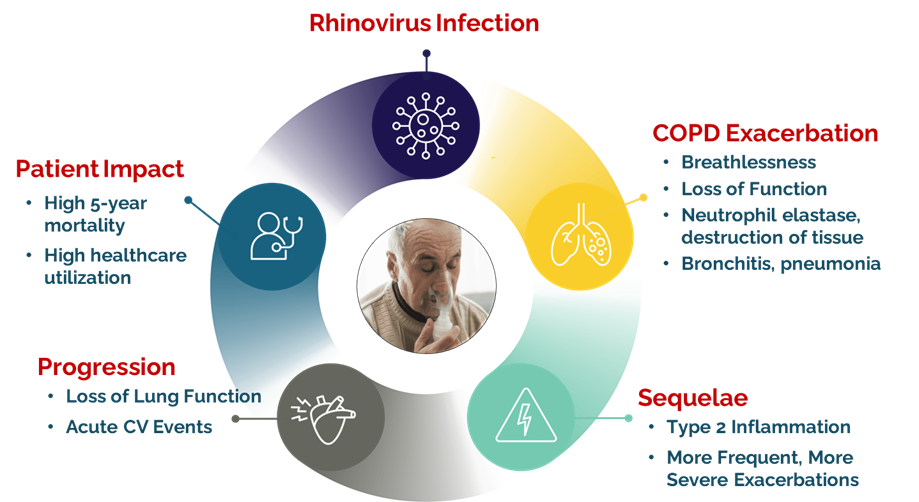Impact

Rhinovirus infections trigger a vicious cycle of inflammation, loss of lung function and severe health consequences. The only way to interrupt this vicious cycle is to treat the rhinovirus infection before it can inflict damage.
When a person with COPD is infected by rhinovirus, the first symptoms are typically those of a common cold. Then, in many cases, the virus gradually infects the lungs and causes damage and inflammation that lead to breathlessness, increased secretions, and potentially bronchitis and pneumonia. Recovery often takes several weeks, but many people never fully recover.
Even among those who do recover, one exacerbation generally leads to more frequent and more severe exacerbations, and repeated viral infections fan the flames of lung inflammation that can make each infection worse.
Exacerbations not only worsen overall lung function but put patients at risk of strokes and heart attacks within the months following infections and exacerbations. As a result, the life expectancy of people with COPD and exacerbations is shortened.
Altesa’s vision is to interrupt this cycle before it starts.
For millions of people with chronic conditions, a cold is never “just a cold.” In the future, we hope to apply the same treatment paradigm for COPD to many other people with unmet medical needs:

The elderly, especially those in long term care

Adults and children with lung diseases like asthma, cystic fibrosis, primary ciliary dyskinesia, bronchiectasis, and pulmonary hypertension

People with specific conditions like Sickle Cell Disease for whom a rhinovirus infection can trigger a life-threatening “chest syndrome”

People with compromised immune systems (natural or acquired), including those undergoing solid organ or stem cell transplants or cancer treatments

Newborns and infants who can contract meningitis and from a virus related to rhinovirus that is also targeted by Vapendavir
How will patients know if they have a rhinovirus infection?
The earliest symptoms of rhinovirus infections are those of a common cold: runny nose, scratchy or sore throat, sneezing or coughing, and general malaise. If you have these symptoms, especially in the early fall or spring, you probably have rhinovirus.
But patients and health care providers don’t need to guess. Today’s new generation of highly sensitve and easily accessible diagnostic tests can detect viral infections at their earliest stages with the resulsts in minutes. These tests are widely available now at clinics and even some pharmacies. By late 2026, we expect that home tests for rhinovirus will be available especially to people with COPD and asthma.
